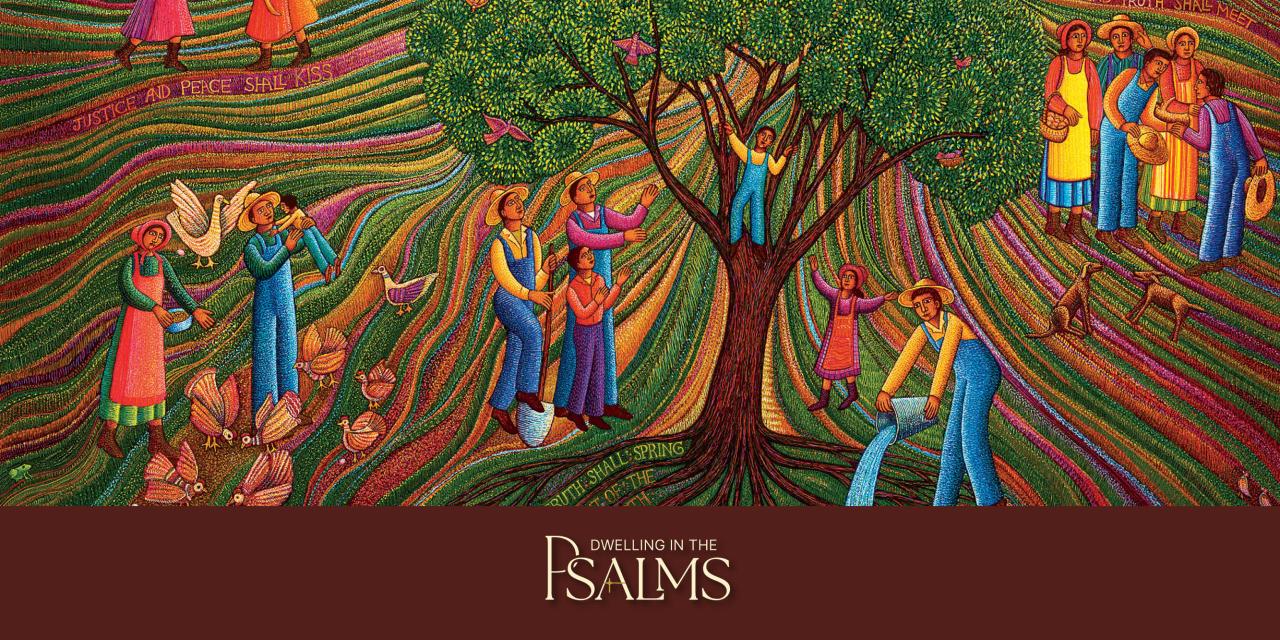She is the past president of CIVA (Christians in the Visual Arts). In this edited conversation, based on emails in November 2013, Bowden talks about the late Sadao Watanabe, an internationally known printmaker who illustrated the gospel in a Japanese context.
How do you describe Sadao Watanabe to people who’ve never heard of him?
Sadao Watanabe (1913-1996), Japan’s foremost Christian artist, converted from Buddhism to Christianity at the age of 17. He soon combined his new faith with an interest in preserving the traditional Japanese folk art of stencil dying, or katazome, by creating colorful representations of biblical scenes that he hoped would speak to his people. He said, “I owe my life to Christ and the gospel. My way of expressing my gratitude is to witness to my faith through the medium of biblical scenes.”
He created a body of art that is an expression of deep faith as well as a valuable contribution to the history of Christian art. His prints are part of many international collections, including the Vatican Museum, National Galleries in Washington, D.C. and London, the Metropolitan Museum of Art in New York, the Museum of Fine Arts in Boston and the National Museum of Modern Art in Tokyo.
What’s an example of how Watanabe illustrated the gospel in a Japanese context?
He said, “My task is to stand within the artistic tradition of Japan…Theology will not take deep root in Japanese soil if it is merely an import.” He also said, “I have always aspired to portray stories and episodes from the Bible. In this disturbed world, I would like to be able to heed the voice of heaven.”
One way Watanabe offered a distinctly Japanese element was by depicting biblical characters robed in Japanese kimonos. In Watanabe’s depictions of the Last Supper, the main course is fish or sea bream, which is served on festive occasions in Japan. Quite often in the Last Supper he would include sake bottles and plates of sushi spread on the table—all familiar foods at a Japanese meal.
Given that Japanese art history includes few Christian artists, where did Watanabe look to find ways to apply his faith to his art?
Two sources fed Watanabe’s imagination. First, he was deeply influenced by the mingei folk art movement that wanted to revive and preserve traditional Japanese folk arts. Watanabe found an idiom that merged both his art and his faith, using a traditional Japanese stencil art form for dyeing kimonos that he hoped would speak to his people.
Second, the medieval art of Europe had a profound impact on his work, and there are many pieces that artistically quote medieval sculpture and painting. However, his own vision was the strongest force as he developed his own visual vocabulary and style.
Did Watanabe make his living by selling art? How widely were or are his biblical prints known and appreciated in Japan?
Watanabe did make his living from selling his art. Those close to him warned him that it would be unwise to dedicate his life to making biblical art, but his commitment to his calling never wavered, and he faithfully pictured the Bible. He lived in a culture that was Buddhist, but a Christian community surrounded him. In fact, and quite remarkably, The Logos Church of the United Church of Japan published three small books of his art between 1976 and 1983.
A gallery championed his art in Tokyo, which exposed his work to both Japanese and international visitors. Two events launched Watanabe’s art internationally. In 1960, novelist James Michener chose Watanabe as one of the ten most important Japanese printmakers for the publication of a suite of work that appeared in his book The Modern Japanese Print. Also, a Benedictine priest bought 18 pieces that now hang in the Vatican Museum of Contemporary Religious Art. But his own country never embraced him with the same enthusiasm as the Western church did.
What made you start collecting his biblical art, and what inspired you to co-author a book on him and create a traveling exhibit?
His interpreter, Dr. I. John Hesselink, then president of Western Theological Seminary, introduced me to the art of Sadao Watanabe. I knew immediately that I wanted to have Watanabe prints in our family art collection, so I made arrangements with Dr. Hesselink to locate some for us the next time he returned to Japan. In the summer of 1988 he sent me five prints. Little did I know that this would be the beginning of an amazing journey that would eventually lead to organizing and curating an entire exhibition of Watanabe’s work and publishing an accompanying book, Beauty Given by Grace: The Biblical Prints of Sadao Watanabe.
How might or do people use Watanabe’s art to meditate on scripture?
I would invite people to use Watanabe’s art as a way to see the Scriptures with new vision and insight. He read and meditated on the Bible before he created each piece, very much like the ancient monastic practice of lectio divina (divine reading). Through the eyes of such a dedicated and humble artist, we are welcomed to see the Bible afresh, but it takes time and a willingness to “see,” not just a casual look.
|
See the traveling exhibit Beauty Given by Grace: the Biblical Prints of Sadao Watanabe at the 2014 Calvin Symposium on Worship, January 30 through February 1. Enjoy learning more in an all-day Watanabe seminar (#6) and gallery walk with John Hesselink and co-authors Sandra Bowden and John Kohan. Get tips in Bowden’s workshop on planning and developing church galleries and exhibits (A5). |

